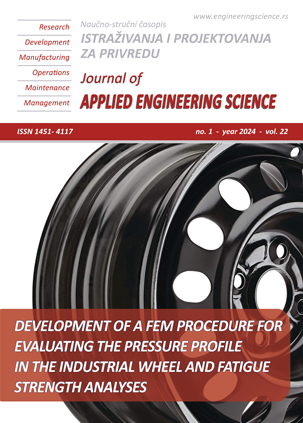DETERMINATION OF ORIENTATION PARAMETERS AND AUTOMATIC WIND WHEEL SPEED CONTROL
Abstract
The design of the wind wheel and storm protection will help greatly improve the performance and safety of the wind-powered water-lifting unit. This, in turn, will contribute to improving the quality of life of rural residents. The authors of this study developed the design of a wind-powered water-lifting unit. The research aims to develop a wind-powered water-lifting unit with a capacity of up to 2.5 m3/hour, resistant to hurricane gusts of wind, with automatic control of wind wheel speed. The mathematical expressions used consider the force of the airflow and the screen area of the side blade, which takes the plane of the wind wheel out of the wind when it increases to values above the permissible operating wind speed. Numerical methods were used to calculate the forces on the spring returning the wind wheel plane to the initial position at different wind speeds. The dependences of the effect of airflow velocity on the free rotation of the wind wheel, i.e., without its running out of the wind, have been determined.
References
Decree of the Government of the Republic of Kazakhstan (October 12, 2021) On approval of the national project "Sustainable economic growth aimed at Improving the Welfare of Kazakhstanis". no. 730.
Lim N., Zhanadilova J., Chadiarova D., Kim M. (2021). PWC. First edition. Overview of the renewable energy market in Kazakhstan: potential, challenges and prospects.
Bayray М., Kiros Н., Abdelkadir М., (2015). Performance of Wind Pump Prototype. Momona Ethiopian Journal of Science. vol. 7, no. 2, 176-190, DOI: 10.4314/mejs.v7i2.3.
Chehouri A., Younes R., Ilinca A., (2015). Review of performance optimization techniques applied to wind turbines. Applied Energy. vol. 142 ,361-388, DOI:10.1016/j.apenergy.2014.12.043.
Han Cao, (2011). Aerodynamics Analysis of Small Horizontal Axis Wind Turbine Blades by Using 2D and 3D CFD Modelling. Engineering and Physical Sciences at the University of Central Lancashire, Preston, England.
Ramzan Luhur M. (2016). A review of the state-of-the-art in aerodynamic performance of horizontal axis wind turbine. Wind and Structures. vol. 22, no 1, 1-16, DOI: http://dx.doi.org/10.12989/was.2016.22.1.001
Bekir Y. (2021). Water Pumping Systems with Wind Turbines in Sinop. European Journal of Science and Technology. no. 31, 515-522, DOI: 10.31590/ejosat.1010299.
Mathivanan S., Amrith S., Jemshid A., Anvar Sadik N. (2021). Design and Fabrication of Water Pumping Mechanism using Wind Energy. ETEDM. vol. 9, no. 10, 98-102, DOI: 10.17577/IJERTCONV9IS10025.
Global wind energy council. (2022). Global wind report.
Martin O. (2015) Aerodynamics of Wind Turbines. Third edition.
Malliotakis G., Nikolaidis N., Baniotopoulos C., (2020). Small wind turbines: Sustainability criteria related to the local built environment. IOP Conference Series: Earth and Environmental Science. vol. 410, 1–13. DOI:10.1088/1755-1315/410/1/012046
Abishev K., Assylova K., Kassenov A., Baltabekova A. (2023). Determination of the value of tangential force for the half-track traction vehicle with rubber tracks. Journal of Applied Engineering Science. vol. 21, no 2, 411–417, DOI: 10.5937/jaes0-39677
Dahham, A., Kasenov, A., Aljibory, M. (2023). Design parameters and mechanical efficiency of jet wind turbine under high wind speed conditions. Open Engineering. vol. 13, no. 1, 1-9, DOI: 10.1515/eng-2022-0450
Mitrovic C., Vorotovic G., Petrovic N., (2014). Advanced structural testing methods for small wind turbines blade up to failure. Journal of Applied Engineering Science. vol.12, 129-136, DOI: 10.5937/jaes12-5787
Ivanov K., Knol O., Balbayev G., (2014). Adaptive Transmission of Wind Turbine. American Journal of Mechanics and Applications. vol. 2, no. 6, 35-38, DOI: 10.11648/j.ajma.s.2014020601.17
Muhammad S., Wang Y., Muhammad B., (2020). Comparison of Small-Scale Wind Energy Conversion Systems: Economic Indexes Clean Technol. vol. 2, no. , 144-155, DOI: 10.3390/cleantechnol2020010
Nurkimbayev S.M., Shumeiko I.A. (2022). Highly efficient small-capacity wind power plant with storm protection. Bulletin of Toraigyrov University. Energetics series. vol. 3, 224-241, DOI: 10.48082/RRAK3496.
Nurkimbayev S.M, Shumeiko I.A., Kassenov A.Z. (2023) Choosing the Optimal Variant of the Shape and Relative Area of the Blade of the Wind Wheel of a Low-power Wind Power Plant. University Proceedings. Engineering. vol. 2, no. 91, 25-33, DOI: 10.52209/1609-1825_2023_2_25
Nurkimbayev S.M., Shumeiko I.A., Itybaeva G.T. (2023). Research and Justification of the Parameters of the Wind Wheel of a Low-power Wind Power Plant for Various Purposes. University Proceedings. vol. 3, no. 92, 72-78, DOI: 10.52209/1609-1825_2023_3_72
Nurkimbayev S.M., Shumeiko I.A., Itybaeva G.T. (2023). Calculation of the mechanism of autonomous control of the wind wheel rotation speed and storm protection. Science and technology of Kazakhstan. vol. 4, 90-101, DOI: 10.48081/JRHA6312

